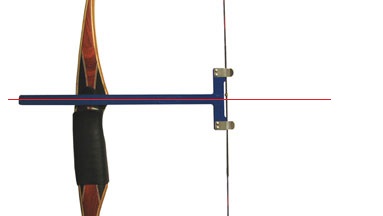Before you get started, make sure that all the items you’ll be using on your recurve bow are instaled – things like stabilizers, bow sight, string, quiver, and so on. You want your bow to be as complete as possible because whenever you introduce a new component you will likely need to make some tuning adjustments. This is a critical step that in my experience is often overlooked by archers, particularly those who are only experienced with a
crossbow (which typically require very minimal tuning, if any).
Our first step is making sure that all the parts of your bow are properly installed. Let’s start with the nocking point.
Perfect Nocking Point Location
Make sure to purchase a nocking point with your bow as they usually don’t come with the package, unless you are buying an entire recurve bow set with arrows and everything included. When installing the point, make sure it is positioned approximately half an inch above “square.”
Square refers to the imaginary line that extends from the surface of your arrow rest and forms a 90 degree angle with the bow string when in its lose position. You can use a T-square device to measure that precisely, though it can be done with just the arrow if you take your time and do things accurately. See image below:
See that red vertical line that I drew? You want to place your nocking point 0.5″ above it. You may need to adjust this ever so slightly, but we’ll get to that later in the tuning process.
At this point it’s worth mentioning that the nock on your arrow should have a proper fit for the nock point on your string. As a rule of thumb, you want the fit to be tight enough so that the arrow can hang freely from the string, with the nock/nock point being perfectly capable of supporting the arrow’s weight. At the same time, the arrow should be able to disengage if the string is given a strong tap (with your hand) a few inches away from the nock.
Don’t let this distract you; many people spend months upon months researching the perfect arrows before they actually buy their recurve. Yes, the type of arrows you use is really important. But it is also certain that no amount of research you do will actually help you choose the “perfect” arrows for your bow; only practice and time will help you determine that, as you will never know what the ideal arrows are before you get to intimately understand the behavior of your
particular bow. So my advice is to simply get one or two different
types of quality arrows, try them out with your recurve bow, see how accurate they are, and then try to improve from there once you gain some
practical experience. Any other approach is just a waste of your time.
Micro-Tune The Brace Height
By brace height we simply mean the distance between the deepest part of the bow riser, and the string in its loose position.
The vast majority of recurve bows have a brace height somewhere between 7.5 and 9.75 inches. The brace height of your bow will dictate some of its behaviors, such as how loud it shoots and how much pivoting your arrow will experience mid-air. On most recurves you’ll be able to adjust the brace height by up to 1/2″ in both directions (either increase it or decrease it). How do you do that?
By twisting the string as you string your bow. The more twists you add at the tip of the string, the more more “flexed” it becomes, hence pulling the limb tips slightly away from the riser and increasing brace height. Similarly, if you want to decrease the brace height, you will reduce the number of twists on the string. The instruction manual that came with your recurve bow will include the manufacturer’s recommendation as to an acceptable brace height range.
Your goal is to twist and untwist the bow string until you reach a brace height that results in the least noise and vibration when an arrow is shot. It’s a good idea to ask someone to stand next to you and tell you when the bow is being the most quiet, as it can be difficult for the archer shooting the bow to judge this properly due to very close proximity to the string.
Step by step:
Simply string your bow, measure the brace height using a ruler, shoot 10 or so arrows, then adjust the brace height by 1/8 of an inch up or down by adding or removing a few twists. Make sure to measure the exact brace height after every change made, note it down, and assign each setting a subjective “noise” rating based on how loud it tends to be when shooting the arrows. At this point don’t worry too much about your shooting accuracy.
Once you’ve found the ideal brace height (which will differ depending on your bow, string materials, and type of arrows you’re shooting), it’s best to write the exact height in inches onto the inside of the limbs of your bow, using a permanent marker. This is a very important value and you want to always have it available “on hand.”
Note: ideal brace height varies from bow model to another, and can even vary slightly across two different bows of the same make and model. You should therefore never rely on another person’s suggestion regarding the brace height to use, and always follow the procedure above to determine the appropriate height for your setup.
























%2Bof%2Bmsss%2Bmemanah%2Bdi%2Bbintulu%2B2015%2B139.jpg)
%2Bof%2Bmsss%2Bmemanah%2Bdi%2Bbintulu%2B2015%2B131.jpg)
%2Bof%2Bmsss%2Bmemanah%2Bdi%2Bbintulu%2B2015%2B133.jpg)
%2Bof%2Bmsss%2Bmemanah%2Bdi%2Bbintulu%2B2015%2B142.jpg)
%2Bof%2Bmsss%2Bmemanah%2Bdi%2Bbintulu%2B2015%2B149.jpg)





























